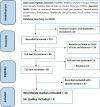A Comparative Analysis of the Quality of Root Canal Fillings of In Vivo Studies Conducted in Saudi Arabia and Worldwide: A Systematic Review
- PMID: 39291238
- PMCID: PMC11407322
- DOI: 10.2147/CCIDE.S479321
A Comparative Analysis of the Quality of Root Canal Fillings of In Vivo Studies Conducted in Saudi Arabia and Worldwide: A Systematic Review
Abstract
Aim: Root canal treatment (RCT) is a common procedure practiced daily by dentists worldwide. The current systematic review aimed to evaluate and compare clinical studies on the quality of root canal fillings (RCFs) carried out by dentists with different levels of experience conducted worldwide with those conducted specifically in Saudi Arabia (SA).
Materials and methods: A full literature search was conducted in Clarivate Analytics' Web of Science, Elsevier's Scopus, Embase, CINHAL, and PubMed, without a restriction to studies published before January 2015. Also, a manual search was carried out by checking papers that may have been missed during the electronic search. The following keywords were used: [(quality of root canal filling(s)) OR (quality of root canal obturation)) and dental practitioners as (general dental practitioners; final year students; endodontist; specialist) AND (root canal obturation) OR (endodontic treatment)]. Parameters of the quality of RCFs, such as length, density, and taper, were assessed and counted.
Results: A total of 13 worldwide and nine SA studies were included in this review, published between 2015 and 2023. Molars were the most treated teeth, at 42.3% and 40.2% for the worldwide and SA studies, respectively. Cases treated by final year students had the highest percentage, at 60.0% for both study groups. The percentages of acceptable quality, with regard to the length, density, and taper of RCFs, were 70.9%, 77.6%, and 84.3%, and 73.2%, 64.6%, and 67.8% for the worldwide and SA studies, respectively.
Conclusion: The overall acceptable quality of RCFs was marginally higher in worldwide studies than in SA studies. Both prevalences can be considered as good, which indicates that the quality of RCFs is moving in the right direction.
Keywords: Saudi Arabia; clinical studies; obturation; procedural errors; quality; root canal filling.
© 2024 Alshahrani et al.
Conflict of interest statement
The authors report no conflicts of interest in this work.
Figures




Similar articles
-
Quality of Root Canal Fillings and Procedural Errors for In Vivo Studies Prepared in Different Clinical Settings and with Rotary Systems: A Systematic Review.Med Sci Monit. 2024 Aug 6;30:e945225. doi: 10.12659/MSM.945225. Med Sci Monit. 2024. PMID: 39104083 Free PMC article.
-
Radiographic Assessment of the Quality of Root Canal Filling of Mandibular First Molars Performed by Endodontists in Asir Region, Saudi Arabia.J Contemp Dent Pract. 2024 Jul 1;25(7):624-630. doi: 10.5005/jp-journals-10024-3666. J Contemp Dent Pract. 2024. PMID: 39533931
-
Assessment of the quality of root canal fillings performed on extracted teeth by undergraduate dental students in a sample from Saudi Arabia.BMC Med Educ. 2024 Feb 19;24(1):157. doi: 10.1186/s12909-024-05136-4. BMC Med Educ. 2024. PMID: 38374029 Free PMC article.
-
Effects of Clinical Training and Case Difficulty on the Radiographic Quality of Root Canal Fillings Performed by Dental Students in Saudi Arabia.Iran Endod J. 2015 Fall;10(4):268-73. doi: 10.7508/iej.2015.04.012. Iran Endod J. 2015. PMID: 26523143 Free PMC article.
-
Hydraulic (Single Cone) Versus Thermogenic (Warm Vertical Compaction) Obturation Techniques: A Systematic Review.Cureus. 2024 Jun 22;16(6):e62925. doi: 10.7759/cureus.62925. eCollection 2024 Jun. Cureus. 2024. PMID: 38912073 Free PMC article. Review.
References
-
- American Association of Endodontists. Endodontics: colleagues for Excellence. Available from: https://bestendoglenview.com/wp-content/uploads/2012/04/Obturation-of-ro.... Accessed September 03, 2024.
Publication types
LinkOut - more resources
Full Text Sources

